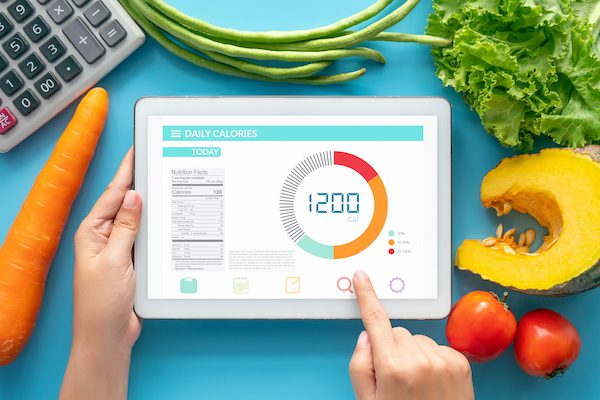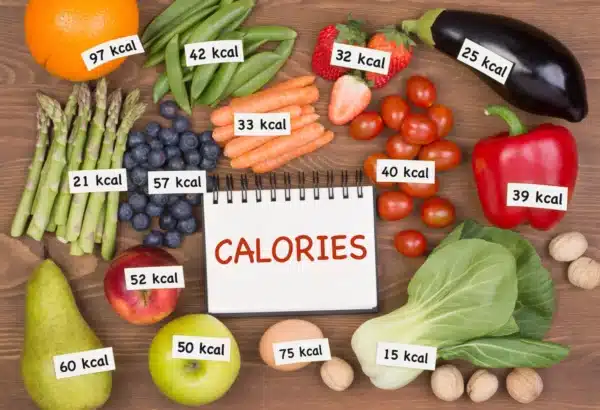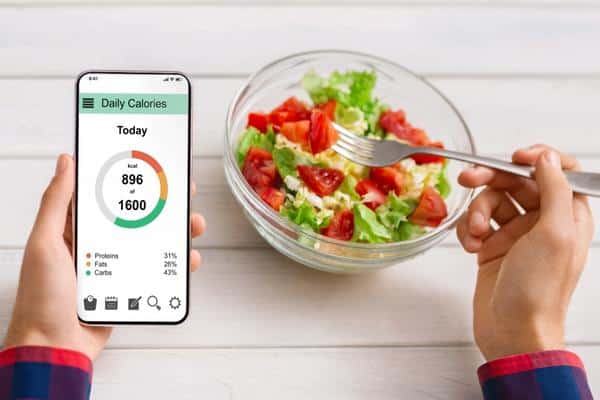The numbers show you how to lose the most weight fast. Frustration causes many people to quit too soon when the fat refuses to budge. Numbers guarantee results on a weight loss journey. Also, knowing the numbers can help with your food budget.
You need to know the numbers that are stopping you from losing weight. Unless you are in a calorie deficit, you will not lose weight.
A calorie deficit means you ate fewer calories than you burned. Each calorie deficit comes with a specific amount of calories lost. Some people think they are in a calorie deficit when they are in a calorie surplus. When you are in a calorie surplus, you are gaining weight.
The reason you need the numbers is because of processed foods. The relationship between processed foods and calories is unnatural.
Natural food has a close relationship with calories. The size of raw food is a powerful indicator of its calories. But, with processed food, a slice of cake can have more calories than an entire meal.
The math used to plan a weight loss journey is simple subtraction and division. Use a calculator if you don’t want to do it yourself.
But, whatever you do, don’t ignore them. The numbers will help you reach your destination fast. Also, it will prevent you from getting lost along the way.
According to the research, 21.5% of men and 19.4% of women reported using the recommended combination of eating fewer calories and engaging in at least 150 minutes of leisure-time physical activity per week.

What numbers to know to lose weight?
Not all math requires complicated formulas. Some of the most potent math is simple. The numbers you need to know to lose weight comes in four levels.
You will use nominal, ordinal, interval, and ratios in a successful weight loss journey. Nominal means name only. This number requires no calculations. You only need to know the number.
For example, you ate 1500 calories and used 1700 calories. Ordinal numbers place numbers in order. For instance, 1700 calories used are over 1500 calories consumed. Interval numbers find the difference between two numbers.
For example, 1700 calories minus 1500 calories is a 200-calorie deficit. Ratios use division to compare two numbers. For instance, 1500 calories divided by 1700 calories means you ate 88% of your calorie budget.

The first way numbers help you lose weight fast is through Calories.
You understand the key players in your weight loss journey using nominal numbers. The most important player is food. Fat comes from food, and food gives you the energy to exercise.
Food is the elephant in the room. You must know the calories in your food. The foods you eat all the time, you should know those by heart. The others you can figure out as you eat them.
By understanding the calories in your food, you can adjust your diet in real time. If you eat 1400 calories and your metabolism is 1700, then you have eaten your calories for that day.
You also need to know the calories in your activities. It’s not wise to spend a lot of time on something that will not make a difference.
Also, exercise is a big eraser when you make a mistake. People who exercise can overeat and still not get fat. While others add extra calories to their waistlines, people who exercise burn the calories up.
Before you start an exercise regimen, research it and know how many calories it burns. By learning the calories in your exercise, you picture how your body uses and stores fat.
The calories in fat are a significant number you need to know. How can you plan a fat loss journey without knowing how many calories are in fat?
The correct answer is 3500 calories in one pound of body fat. To lose weight, you must create a 3500 calorie deficit to lose one pound of body fat. Understanding this number helps you determine how long your journey will take.
One of the most important numbers you need to know is the calories in your metabolism. This number is unique. The calories in food and fat are the same for everyone.
But the calories in your metabolism and exercise are specific to your body. Your health, weight, height, activities, and genetics determine the calories in your metabolism.
There is an average metabolism for each body type. You may underperform or outperform that number, given your body and activities.
On a journey, you don’t have to be perfect. While getting the numbers as authentic as possible is good, a reasonable estimate will also do. It takes 3500 calories to lose one pound of fat.
If you are off by 15 or 20 calories daily, it will not make a big difference on your journey.

The Second way numbers help you lose weight quickly is through calorie deficits
You can make excellent decisions when you know the calories in food, exercise, body fat, and metabolism. You can plan out your meals and guarantee you don’t overeat. You don’t have to count calories to get results. A reasonable estimate works when you have the numbers.
The numbers determine your success or failure. They tell a story about your weight journey. You write a story about the foods you eat and the exercises you perform. Ordinal numbers help you to see how the story ends. To get a happy ending, your metabolism and exercise calories must be more than your food calories.
Setting up a budget is the best way to reach your goal. The metabolism of an average person is around ten times their body weight. So multiply your body weight by 10 to estimate your metabolism. If you get an excellent result, leave it alone. But if the results are wrong, then decrease your metabolism.
Also, you could start eating better. A healthy metabolism comes from healthy organs. About 51% of your metabolism comes from your heart, kidneys, liver, and brain.
The food you eat affects these organs more than most other organs. This explains why alcohol damages these four quicker than the rest of your body.
To learn more about your diet, use interval numbers. This type of math calls for you to compare two numbers by subtracting them.
Food – metabolism – exercise = calorie deficit. The goal is to create an enormous loss. The more significant the loss, the faster you reach your weight loss goal. While eating less helps, eating less and moving more help even more.
A calorie deficit lets you know how much weight you lose daily. If you have a 700-calorie deficit a day, then in 5 days, you will have reached a 3500-calorie deficit.
The nominal math reminds us it takes a 3500 calorie deficit to lose a pound of body fat. With this knowledge, you are on your way to planning and executing an entire weight loss journey.
The third-way numbers help you lose weight quickly is through conversion rates.
So now you know about calories and calorie deficits, but what do you do with this information? You can lose weight with this information alone.
But to understand even more about your weight journey requires more math. Ratio numbers provide you with a sharper tool to decide. You can find averages, percentages, and rates when dividing two numbers. Ratios give you some powerful stuff to work with.
Did you know you can convert your body weight to calories? If you want to lose 15 pounds, multiply it by 3500 calories to reach 52,500 calories. Now that is a lot of calories.
Let’s say you have a calorie deficit of 350 calories a day. You can use division to determine how many days it takes to lose weight. By taking the 52,500 calories and dividing it by 350 calories, you get 150 days or five months.
If that is too long, you can always increase the calorie deficit by eating less or exercising more. It takes a second to eat less and an hour to exercise more. You decide. But now you know. The cat is out of the bag.
The best thing about ratios is that you can convert anything to anything by dividing them. We can use rates to move back and forward with calories, time, and weight.
So at any point, we can use one to figure out the rest. Now, we can determine how many calories we need to eat.
Also, we can figure out how much time to lose weight. Lastly, we can calculate how much weight we can lose. This knowledge gives us the power to precisely plan and executes a weight loss journey.

How do we put it all together to complete a fast and successful weight loss journey?
The first thing we need is a SMART goal. SMART stands for specific, measurable, attainable, relevant, and time-specific. A specific goal should involve two different units of measurement or more. Some units of measurement are time, weight, percent, and calories. The math helps you determine if the goal is attainable.
Also, a relevant goal helps you reach your weight loss destination. Finally, all goals end. Either you complete the goal, or you quit. So, what does a SMART goal look like? To lose 20 pounds in 70 days is a SMART goal.
Once you determine the goal, the next step is identifying two or more tasks. The task should involve eating or moving. Also, the task should help you reach the goal. The numbers say 20 pounds equals 70,000 calories (3,500 calories x 20 pounds).
To lose 30 calories in 70 days, you need a 1000-calorie deficit daily (70,000 calories / 70 days). You could eat 1000 calories less than your metabolism to reach your goal.
But you could also use exercise to make up for some of the calorie deficit. Thus, you could eat 700 fewer calories and do 300 more calories of exercise to reach the calorie deficit.
Eating fewer calories or exercising more makes your food’s quality critical. Some foods encourage you to eat less. They have a high satiety index. Other foods encourage you to eat more because of the chemicals in them.
Protein is food that keeps you full longer and builds muscle. Complex carbs like potatoes and green vegetables keep you full longer and heal your body. Add some healthy foods to your diet and eat a calorie deficit daily to reach your weight loss goal.
No weight loss goal is complete without two or more metrics to track your success. The scale is a metric everyone should use.
While it is not precise, it gives you a general outlook on your health and fitness. Weigh yourself twice a week at the same time. Understand that your weight may fluctuate due to water or the digestion of foods.
Some foods take longer to digest but still contribute to your weight. Other foods have sodium, which causes your body to hold on to more water. You will need a more specific measurement to go along with the scale.
Use a measuring tape or belt to track your weight loss journey. Like weight, the waistline is an excellent way of tracking your fitness. There is a relationship between your weight and your waist. Smaller people have smaller waistlines. The waistline is a more accurate metric, but it takes longer to see results.
If one of your tasks involves exercise, you can use time, distance, or volume to track a weight loss goal. Exercise performance equates to weight loss. As your fitness improves, so will your health. There is a reason marathon runners are skinny, and weightlifter is muscular. Your body will become what it does the most.
Only what you measure grows. Track your performance and reach your results faster
Finally, a weight loss journey is like a story. It has many twists and turns that numbers can help you see and prepare for.
To lose weight requires deliberate actions. Numbers help you calculate how to lose weight. Also, it shows you a realistic picture of the journey. You can use math to determine how long it takes to lose weight.
How many calories do you need to eat to lose weight? Create a realistic goal, adopt some tasks, and finally use two or three metrics to reach the goal. Weight loss is not magic but science. What better science to use than math to lose weight?




